Tigranakert of Artsakh
Tigranakert (Armenian: Արցախի Տիգրանակերտ, Arts'akhi Tigranakert), also known as Tigranakert-Artsakh,[1] is a ruined Armenian city dating back to the Hellenistic period, located in the Agdam District of Azerbaijan.
.jpg.webp) Fragment of Tigranakert's city wall | |
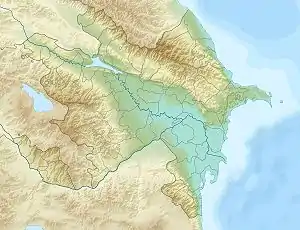 Location within the Azerbaijan | |
| Location | Agdam, Azerbaijan |
|---|---|
| Coordinates | 40°03′55″N 46°54′21″E |
| History | |
| Builder | Tigranes the Great |
| Founded | 2nd–1st century B.C. |
| Site notes | |
| Excavation dates | 2005–present |
It is one of several former cities in the Armenian plateau with the same name, named in honor of the Armenian king Tigranes the Great (r. 95–55 B.C.), with the name Artsakh referring to the historical province of Artsakh in the ancient Kingdom of Armenia.[2] Some scholars, such as Robert Hewsen and Babken Harutyunyan, have posited that this particular Tigranakert may also have been founded by Tigranes the Great's father, Tigranes I (r. ca. 123–95 B.C.), however.[3] It occupies an area of about 50 hectares and is located approximately four kilometers south of the Khachinchay River.
It came under the occupation of Armenian forces after the First Nagorno-Karabakh war and was made part of the self-proclaimed Republic of Artsakh until November 2020 when it was handed over to Azerbaijan as part of the 2020 Nagorno-Karabakh ceasefire agreement.
History

Primary sources first make mention of Tigranakert in the seventh century, stating that there were actually two such cities with the same name in the province of Utik.[4] Archaeologists and historians have managed to date the founding of the first one to the 120s-80s B.C., during the reign of either King Tigranes I, or his son and successor King Tigranes the Great. Robert Hewsen has questioned the attribution to Tigranes II, as no coins or inscriptions bearing his name have been uncovered yet and the identification of the remains rests on the local name for the site.[5] The ruins of the second Tigranakert have yet to be uncovered, although it is believed to have been located in the district of Gardman.[4] Tigranakert was the site of a battle in the spring of 625 AD, between the Byzantine emperor Heraclius (r. 610–641) and a Sasanian force, which resulted in the defeat of the latter.[6] The site has inscriptions in both Armenian and Greek dating back to the 5th and 7th century.[7]
After the demise of the first Tigranakert in the early Middle Ages, the name of the city was preserved and used continuously in local geographic lore as Tngrnakert, Tarnakert, Taraniurt, Tarnagiurt, and Tetrakerte.[2][4] It was de facto under the control of the self-proclaimed Republic of Artsakh as part of its Askeran Province until being handed over to Azerbaijan, along with the rest of the area around Agdam as a part of the 2020 Nagorno-Karabakh ceasefire agreement. The city reportedly came under shelling by Azerbaijan during the 2020 Nagorno-Karabakh War.[7]
Excavations
Excavations at Tigranakert began in March 2005, when it was first discovered, and are currently ongoing under the directorship of Dr Hamlet L. Petrosyan of the Armenian Academy of Sciences' Institute of Archaeology and Ethnography. Archaeologists have uncovered two of the main walls of the city, as well as Hellenistic-style towers and an Armenian basilica dating to fifth to seventh centuries.[8] In 2008, the excavation team began to face funding issues, although the authorities of the Republic of Artsakh promised to allocate 30 million drams to continue further research.[9] During the excavations of 2008–2010, silver coins of the Parthian monarchs Mithridates IV (r. 57–54 BC) and Orodes II (r. 57–37 BC) were found.[10]
In June 2010, a museum dedicated to the study and preservation of artefacts unearthed from Tigranakert's ruins was opened in the adjacent Shahbulag Castle, near the former city of Agdam.[8]
Gallery


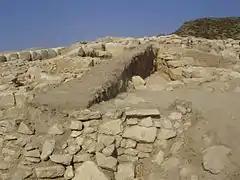 Part of the city defense wall
Part of the city defense wall So-called Lower Borough of the city of Tigranakert
So-called Lower Borough of the city of Tigranakert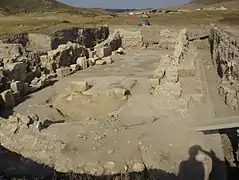 Part of the Lower Borough
Part of the Lower Borough.jpg.webp) Tigranakert city walls
Tigranakert city walls.jpg.webp) Tigranakert city walls
Tigranakert city walls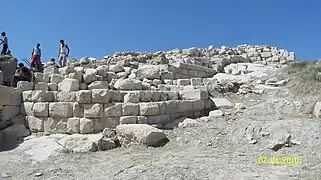 Tigranakert citadel
Tigranakert citadel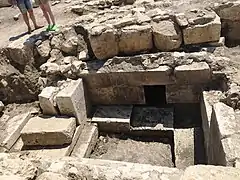



References
- Canepa 2018, p. 104.
- Petrosyan, Hamlet L (2010). "Tigranakert in Artsakh," in Tigranes the Great. Yerevan, pp. 380-87.
- Hewsen, Robert H. (2001). Armenia: A Historical Atlas. Chicago: University of Chicago Press. pp. 58, 73, map 62. ISBN 0-226-33228-4.
- Hewsen, Armenia, p. 58.
- Hewsen, Robert H., "Three New Books about Arts'akh," Journal of the Society for Armenian Studies 22 (2013), p. 295.
- Hewsen 2001, p. 91.
- https://hyperallergic.com/592287/tigranakert-artsakh-nagorno-karabakh-war/
- "Museum at Ancient Ruins of Tigranakert Opens in Nagorno-Karabakh." Asbarez. June 8, 2010. Retrieved July 1, 2010.
- Harutyunyan, Arpi. "Research in Ruins: Tigranakert project threatened by lack of finances." ArmeniaNow. April 11, 2008. Retrieved March 25, 2010.
- Petrosyan 2010, p. 386.
Sources
- Canepa, Matthew P. (2018). "Rival Visions and New Royal Identities in Post- Achaemenid Anatolia and the Caucasus". The Iranian Expanse: Transforming Royal Identity through Architecture, Landscape, and the Built Environment, 550 BCE–642 CE. University of California Press. pp. 95–121. ISBN 9780520964365.
- Petrosyan, Hamlet L. (2010). "Tigranakert in Artsakh". Yerevan: 380–387. Cite journal requires
|journal=(help)
External links
| Wikimedia Commons has media related to Tigranakert (Artsakh). |
- Tigranakert of Artsakh: (in Armenian), (in Russian).
- Zareh Tjeknavorian (Director) (2007). Tigranakert: An Armenian Odyssey. Yergir Union and Naregatsi Film Center.
- Tigranakert of Artsakh on CNN